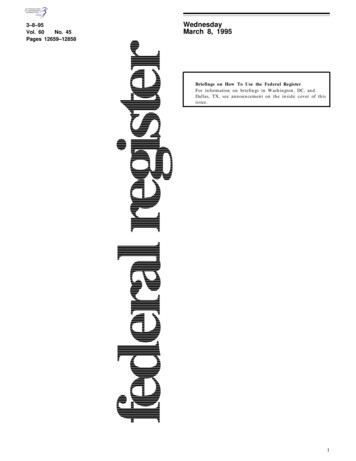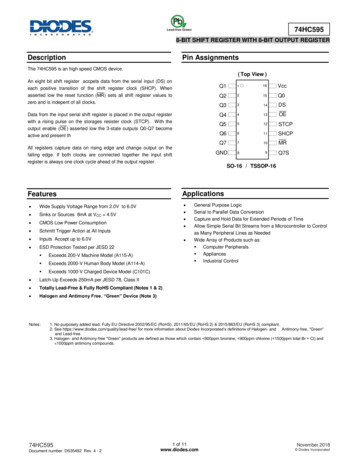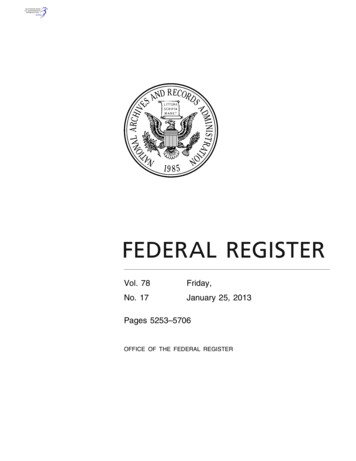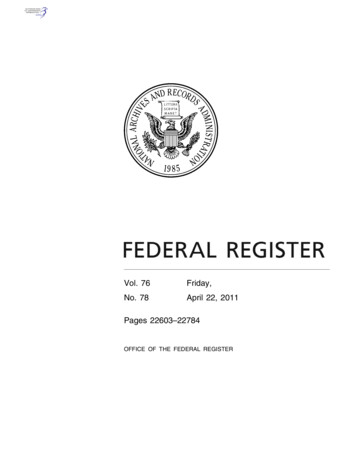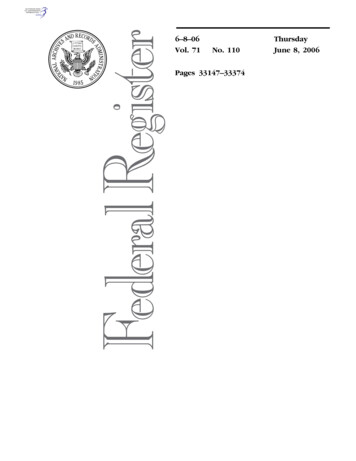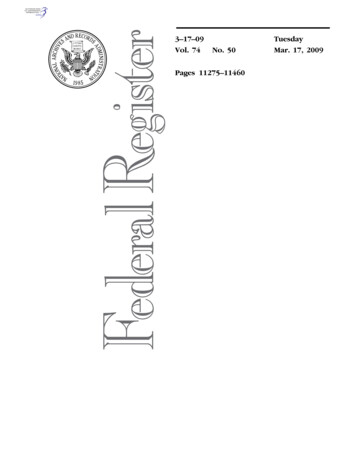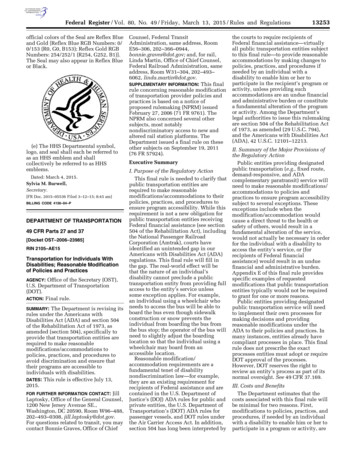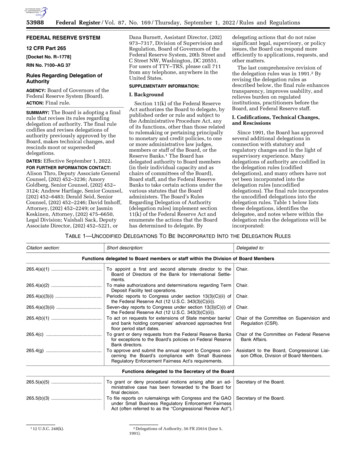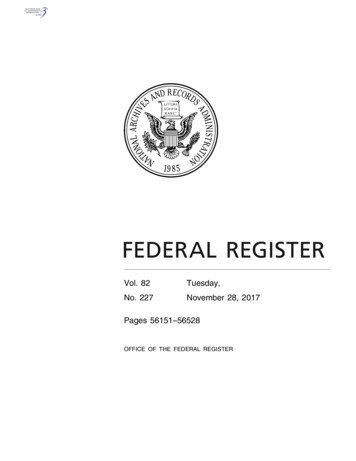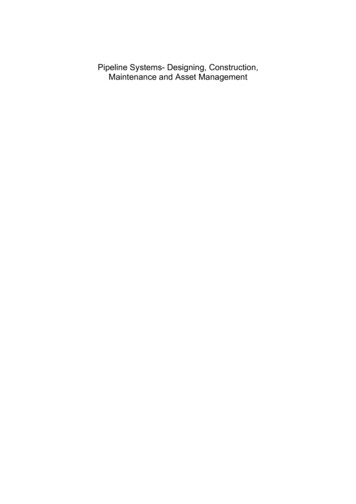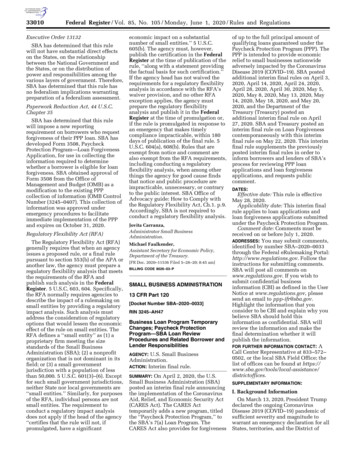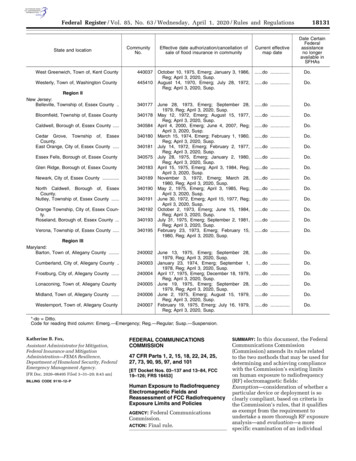
Transcription
18131Federal Register / Vol. 85, No. 63 / Wednesday, April 1, 2020 / Rules and RegulationsCommunityNo.State and locationWest Greenwich, Town of, Kent County440037Westerly, Town of, Washington County445410Region IINew Jersey:Belleville, Township of, Essex County .340177Bloomfield, Township of, Essex County340178Caldwell, Borough of, Essex County .340584Cedar Grove, Township of, EssexCounty.East Orange, City of, Essex County .340180340181Essex Fells, Borough of, Essex County340575Glen Ridge, Borough of, Essex County340183Newark, City of, Essex County .340189North Caldwell, Borough of, EssexCounty.Nutley, Township of, Essex County .340190Orange Township, City of, Essex County.Roseland, Borough of, Essex County .340192340193Verona, Township of, Essex County .340195Region IIIMaryland:Barton, Town of, Allegany County .240002Cumberland, City of, Allegany County .240003Frostburg, City of, Allegany County .240004Lonaconing, Town of, Allegany County240005Midland, Town of, Allegany County .240006Westernport, Town of, Allegany County240007340191Date CertainFederalassistanceno longeravailable inSFHAsEffective date authorization/cancellation ofsale of flood insurance in communityCurrent effectivemap dateOctober 10, 1975, Emerg; January 3, 1986,Reg; April 3, 2020, Susp.August 14, 1970, Emerg; July 28, 1972,Reg; April 3, 2020, Susp.do .Do.do .Do.June 28, 1973, Emerg; September 28,1979, Reg; April 3, 2020, Susp.May 12, 1972, Emerg; August 15, 1977,Reg; April 3, 2020, Susp.April 4, 2000, Emerg; June 4, 2007, Reg;April 3, 2020, Susp.March 15, 1974, Emerg; February 1, 1980,Reg; April 3, 2020, Susp.July 14, 1972, Emerg; February 2, 1977,Reg; April 3, 2020, Susp.July 28, 1975, Emerg; January 2, 1980,Reg; April 3, 2020, Susp.April 15, 1975, Emerg; April 3, 1984, Reg;April 3, 2020, Susp.November 3, 1972, Emerg; March 28,1980, Reg; April 3, 2020, Susp.May 2, 1975, Emerg; April 3, 1985, Reg;April 3, 2020, Susp.June 30, 1972, Emerg; April 15, 1977, Reg;April 3, 2020, Susp.October 2, 1973, Emerg; June 15, 1984,Reg; April 3, 2020, Susp.July 31, 1975, Emerg; September 2, 1981,Reg; April 3, 2020, Susp.February 23, 1973, Emerg; February 15,1980, Reg; April 3, 2020, Susp.do .Do.do .Do.do .Do.do .Do.do .Do.do .Do.do .Do.do .Do.do .Do.do .Do.do .Do.do .Do.do .Do.do .Do.do .Do.do .Do.do .Do.do .Do.do .Do.June 13, 1975, Emerg; September 28,1979, Reg; April 3, 2020, Susp.January 23, 1974, Emerg; September 1,1978, Reg; April 3, 2020, Susp.April 17, 1975, Emerg; December 18, 1979,Reg; April 3, 2020, Susp.June 19, 1975, Emerg; September 28,1979, Reg; April 3, 2020, Susp.June 2, 1975, Emerg; August 15, 1979,Reg; April 3, 2020, Susp.February 19, 1975, Emerg; July 16, 1979,Reg; April 3, 2020, Susp.*-do Ditto.Code for reading third column: Emerg.—Emergency; Reg.—Regular; Susp.—Suspension.Katherine B. Fox,Assistant Administrator for Mitigation,Federal Insurance and MitigationAdministration—FEMA Resilience,Department of Homeland Security, FederalEmergency Management Agency.[FR Doc. 2020–06495 Filed 3–31–20; 8:45 am]FEDERAL COMMUNICATIONSCOMMISSION47 CFR Parts 1, 2, 15, 18, 22, 24, 25,27, 73, 90, 95, 97, and 101[ET Docket Nos. 03–137 and 13–84, FCC19–126; FRS 16453]jbell on DSKJLSW7X2PROD with RULESBILLING CODE 9110–12–PHuman Exposure to RadiofrequencyElectromagnetic Fields andReassessment of FCC RadiofrequencyExposure Limits and PoliciesFederal CommunicationsCommission.ACTION: Final rule.AGENCY:VerDate Sep 11 201416:27 Mar 31, 2020Jkt 250001PO 00000Frm 00027Fmt 4700Sfmt 4700In this document, the FederalCommunications Commission(Commission) amends its rules relatedto the two methods that may be used fordetermining and achieving compliancewith the Commission’s existing limitson human exposure to radiofrequency(RF) electromagnetic fields:Exemption—consideration of whether aparticular device or deployment is soclearly compliant, based on criteria inthe Commission’s rules, that it qualifiesas exempt from the requirement toundertake a more thorough RF exposureanalysis—and evaluation—a morespecific examination of an individualSUMMARY:E:\FR\FM\01APR1.SGM01APR1
jbell on DSKJLSW7X2PROD with RULES18132Federal Register / Vol. 85, No. 63 / Wednesday, April 1, 2020 / Rules and Regulationssite or device, which considers factorsbeyond those utilized for exemption andmay be performed with a variety ofcomputational and/or measurementmethodologies. It also amends the rulesrelated to an increasingly important partof demonstrating and maintaining RFexposure compliance: mitigation—therestriction from or limitation of RFexposure in controlled areas to keep RFexposure within the Commission’sestablished limits by, for example, usingsigns or barriers. The amended rules areintended to provide more efficient,practical, and consistent RF exposureevaluation procedures and mitigationmeasures to help ensure compliancewith the existing RF exposure limits.The amended rules replace the variousinconsistent service-specific criteria forexempting parties from performing anevaluation to demonstrate compliancewith the RF exposure limits with new,streamlined criteria. The amended rulesalso allow the use of any validcomputational method to determinepotential RF exposure levels, removethe minimum evaluation distancerequirement for frequencies above 6GHz, and establish post-evaluation RFexposure mitigation procedures (e.g.,signage), to help ensure that persons arenot exposed to RF emissions in excessof the existing limits. The Commissionalso affirms its prior decision to classifythe pinna (outer ear) as an extremity inRF exposure compliance testing, findsno appropriate basis for and thusdeclines to propose amendments toexisting RF exposure limits at this time,and terminates the inquiry in which itsought comment on the Commission’sexisting guidelines for limiting RFexposure to humans.DATES: Effective June 1, 2020.FOR FURTHER INFORMATION CONTACT:Martin Doczkat, email: martin.doczkat@fcc.gov; the Commission’s RF SafetyProgram, rfsafety@fcc.gov; or call theOffice of Engineering and Technology at(202) 418–2470.SUPPLEMENTARY INFORMATION: This is asummary of the Commission’s SecondReport and Order, MemorandumOpinion and Order, and Termination ofNotice of Inquiry, ET Docket No. 03–137, ET Docket No. 13–84, FCC 19–126,adopted November 27, 2019 andreleased December 4, 2019. The full textof this document is available for publicinspection and copying during normalbusiness hours in the FCC ReferenceCenter (Room CY–A257), 445 12thStreet SW, Washington, DC 20554, or bydownloading the text from theCommission’s website at https://www.fcc.gov/edocs/daily-digest/2019/12/05. Alternative formats are availableVerDate Sep 11 201416:27 Mar 31, 2020Jkt 250001for people with disabilities (Braille,large print, electronic files, audioformat) by sending an email to fcc504@fcc.gov or calling the Commission’sConsumer and Governmental AffairsBureau at (202) 418–0530 (voice), (202)418–0432 (TTY).SynopsisI. Introduction1. On March 27, 2013, theCommission adopted a First Report andOrder (First RF Report and Order),Further Notice of Proposed Rulemaking(2013 RF Further Notice), and Notice ofInquiry (2013 RF Inquiry) in thisproceeding, 78 FR 33654, June 4, 2013.In the 2019 Second Report and Order,the Commission simplified theregulatory framework for determiningcompliance with the Commission’sexisting RF exposure limits byproviding more efficient, practical, andconsistent RF exposure exemptioncriteria, evaluation procedures, andmitigation measures to help ensurecompliance with the RF exposure limits.In the 2019 Memorandum Opinion andOrder, the Commission affirmed itsdecision in the First RF Report andOrder to classify in its rules the pinna(outer ear) as an extremity for RFexposure compliance testing. In the2019 Termination of Notice of Inquiry,the Commission terminated the 2013 RFInquiry that sought comment on theefficacy and propriety of theCommission’s existing guidelines andpolicies for limiting RF exposure tohumans, finding no appropriate basisfor and thus declining to proposeamendments to existing limits at thistime. The following are the majoractions that the Commission took in the2019 Second Report and Order tosimplify the Commission’s RF exposureevaluation procedures and mitigationmeasures and apply them consistently: Created three broad categories forexemption from the RF exposureevaluation requirements for all fixed,mobile, and portable RF sources, basedon power, separation distance(minimum distance in any directionfrom any part of a radiating structure toany part of the human body), andfrequency, that provide for both singleand multiple-transmitter cases and treatlike sources similarly regardless of theunderlying service; adopted the term‘‘exemption’’ to replace ‘‘exclusion’’ forthis topic. Added to § 1.1307(b) of theCommission’s rules a set of technicaldefinitions related to output power,separation distance, RF exposurescenarios and sources, and categories forspecifying RF safety program actionsPO 00000Frm 00028Fmt 4700Sfmt 4700that reflect potential RF exposurescenarios. Replaced restrictive and outdatedprovisions that specified only a singleacceptable numerical approach to RFexposure evaluation, with provisionsallowing the use of any validcomputational method to determine RFexposure levels; allowed parties to makead hoc requests for use of other RFexposure evaluation methods whosereliability and validity can besubstantiated. Removed from § 2.1093(d) of theCommission’s rules the 5-cm minimumseparation specification formeasurements and calculations used todemonstrate RF exposure compliancefor devices that operate above 6 GHz. Established more specific postevaluation RF exposure mitigationmeasures that include access control,signage, and training requirements fortransmitter sites where RF exposurelimits may be exceeded to help ensurethat persons are not exposed to RFemissions that exceed the Commission’sestablished RF exposure limits.II. DiscussionSecond Report and Order2. In the 2019 Second Report andOrder, the Commission amended parts1, 2, 15, 18, 22, 24, 25, 27, 73, 90, 95,97, and 101 of its rules to simplify theprocedures for determining compliancewith the Commission’s existing RFexposure limits to help ensureconsistent compliance with those limits.These actions are described in greaterdetail below.A. Exemptions From the RF ExposureEvaluation Requirement3. As proposed in the 2013 RF FurtherNotice and supported in the record, theCommission revised the various servicespecific criteria for exemption (formerlytermed exclusion) from performing anRF exposure evaluation, to set forth asingle, generally-applicable set offormulas based on power, separationdistance, and frequency of fixed,mobile, and portable transmitters thatare applicable to both single andmultiple sources of RF emissions, andadopted a set of technical definitionsrelated to output power and separationdistance. The Commission adoptedthree broad classes of RF exemptions:(1) For extremely low-power devicesthat transmit at no more than 1 mW; (2)for somewhat higher-power deviceswith transmitting antennas thatnormally operate within 0.5 cm to 40cm of the human body in the frequencyrange between 300 MHz and 6 GHz, aformula based primarily on theE:\FR\FM\01APR1.SGM01APR1
18133localized specific absorption rate (SAR)limits; and (3) for all other transmitters,based on a set of formulas for maximumpermissible exposure (MPE) limits. Thenew exemption criteria apply to all ofthe Commission’s rules authorizing RFsources. Under the new rules, everyapplicant for equipment authorizationand every licensee prior to deploymentor commencement of operations maydetermine whether the device ortransmitter falls under one of the classesof exemptions. If the device ortransmitter falls under one of theseclasses of exemption, no additionalaction is necessary. If not, the applicantor licensee will have to perform aroutine evaluation to determinecompliance with the existing RFexposure limits. The Commissionreasoned that this new process wouldnot impose any significant burdens onimpacted parties since the underlyingexposure rules and parties’ obligationsunder the rules remain the same; thenew rules only modify the process usedto demonstrate compliance.4. In response to comments that therule changes are unnecessary and willbe burdensome and some parties maylose their service-based exemptions, theCommission noted that unlike in thepast, fixed RF communicationsequipment is now located on rooftopsthat are accessible to the public and onother structures near ground level thatare not spatially removed from publiclyaccessible areas at similar heights. Toachieve consistently reliable compliancewith the existing RF exposure limits, theCommission decided that these sorts ofinstallations warrant an affirmativedetermination of compliance with theRF exposure requirements.1. Exemption Criteria—Single RFSource.5. A single RF source will be exemptfrom RF exposure evaluation under anyone of three circumstances: (1) The RFsource transmits at no more than 1 mWtime-averaged available (matchedconducted) power; (2) the RF source isnormally separated between 0.5 and 40cm from the human body, in thefrequency range between 300 MHz and6 GHz, and transmits at no more thanthe average power threshold result fromthe formula the Commission adoptedbased on the localized SAR limits; or,(3) for all other fixed, mobile, andportable transmitters, the RF sourcetransmits at no more than the averagepower threshold result from the set offormulas the Commission adopted basedon the MPE limits at separationdistances from any part of the radiatingstructure of at least l/2p (RF signal freespace wavelength divided by 2p) in allservice categories.6. 1-mW Blanket Exemption. Forextremely low-power fixed, mobile, andportable RF sources, the Commissionadopted a blanket RF exposureevaluation exemption for a singletransmitter operating with up to 1 mWof time-averaged available (matchedconducted) power, irrespective of theseparation distance from the humanbody. The 1-mW exemption isindependent of service type and coversthe full frequency range from 100 kHzto 100 GHz, but it may not be used inconjunction with other exemptioncriteria, or in devices with higher-powertransmitters operating in the same timeaveraging period. The 1-mW blanketexemption applies for any separationdistance, including distances of lessthan 0.5 cm and where there is noseparation, e.g., medical implantdevices.7. SAR-Based Exemption. For fixed,mobile, and portable RF sources near ahuman body, where the separationdistance is normally between 0.5 and 40cm and may be less than l/2p, theCommission adopted the new RFexposure evaluation exemption formulashown here for time-averaged powerthresholds (specified in mW) forexemption of single portable, mobile,and fixed RF sources at 0.3–6 GHz. Asource is exempt if each of themaximum time-averaged available(matched conducted) power andeffective radiated power (ERP) is nomore than:8. The formula provides, as a functionof separation distance and frequency, athreshold power below which a singleRF source is exempt from further RFexposure evaluation. It applies to fixed,mobile, and portable RF sources in anyservice at a separation distance between0.5 cm and 40 cm from the body, andis applicable in the frequency rangefrom 300 MHz through 6 GHz. The SARbased thresholds are derived based onthe frequency, power, and separationVerDate Sep 11 201416:27 Mar 31, 2020Jkt 250001PO 00000Frm 00029Fmt 4700Sfmt 4700E:\FR\FM\01APR1.SGM01APR1ER01AP20.001 /GPH jbell on DSKJLSW7X2PROD with RULESFederal Register / Vol. 85, No. 63 / Wednesday, April 1, 2020 / Rules and Regulations
jbell on DSKJLSW7X2PROD with RULES18134Federal Register / Vol. 85, No. 63 / Wednesday, April 1, 2020 / Rules and Regulationsdistance of the RF source. The formuladefines the thresholds in general foreither available maximum timeaveraged power or maximum timeaveraged ERP, whichever is greater.9. If the ERP of a device is not easilydetermined, such as for a portabledevice with a small form factor,available maximum time-averagedpower (i.e., maximum power deliveredinto a matched antenna, consideringline loss or any other loss thatdiminishes the power delivered to anantenna) may be used exclusively if thedevice antenna or radiating structuredoes not exceed an electrical length ofl/4. A coherent phased array of antennaelements is to be treated as a singleantenna or RF source with separationdistance determined from the nearestantenna element.10. For devices with antennas oflength greater than l/4 where the gainis not well-defined but always less thanthat of a half-wave dipole, the availablemaximum time-averaged powergenerated by the device may be used inplace of the maximum time-averagedERP, in situations where that ERP valueis not known. This would apply, forinstance, to ‘‘leaky’’ coaxial distributionsystems, RF heating equipment, andother typically unintentionally radiatingor Industrial, Scientific and Medical(ISM) devices. The SAR-basedexemption threshold, Pth, is defined interms of maximum time-averaged powerand in accordance with the sourcebased time-averaging requirementsdescribed in § 2.1093(d)(5) of the rules.Time-averaged power measurements arenecessary to determine if the maximumoutput of a transmitting antenna (ERP)or matched conducted transmitterpower is above the proposed thresholdfor exemption from routine SARevaluation. The Commission’s Office ofEngineering and Technology (OET) willpublish in its Knowledge Database(KDB) the power measurement and SARtest procedures necessary todemonstrate compliance with the RFexposure limits.11. While commenters supported thebasic idea of a uniform formula for anSAR exemption, several commentersdisagreed with the proposed formula,contending it was overly conservativeand inconsistent with the operation ofcurrent devices. Instead, partiessupported use of the InternationalElectrotechnical Commission’s (IEC’s)standard IEC 62479 (2010), whichprovides alternative recommendationsfor exemption of low-power devicesbased on SAR. For several reasons, theCommission was not persuaded that theIEC standard was appropriate. Eventhough the IEC’s standard uses dipolesVerDate Sep 11 201416:27 Mar 31, 2020Jkt 250001and flat phantoms as a starting point formodeling, and is applicable to the samefrequency range as the SAR exemptionformula (300 MHz–6 GHz), theCommission determined that the IECstandard departs significantly regardingthe applicable range of separationdistances and use of bandwidth, with anincreased complexity in the resultingformulas. In addition, the IEC modeldoes not directly incorporate antennadirectivity and states that it may notapply to devices with highly directiveantennas. To maintain simplicity, theCommission limited the exemptions tothose based solely on the relationship ofpower (both available or matched powerand ERP), separation distance, andfrequency, without other inputs—suchas antenna pattern or bandwidth—thatwould effectively render an exemptiondetermination as complex as anevaluation. It concluded that additionalcomplexity in the exemptions fromadditional inputs would result inregulations that were of little or nopractical utility as a simple exemptionprotocol; additional factors could beconsidered as needed or appropriate ina more thorough evaluation todemonstrate compliance. TheCommission also declined to extend theSAR-based exemption formula from 0.5cm to 0 cm because there is no modelingdata that validates such an extension.12. MPE-Based Exemption. Tosupport an exemption from furtherevaluation for frequencies from 300 kHzthrough 100 GHz, the Commission alsoadopted general frequency andseparation-distance dependent MPEbased ERP thresholds as shown belowin Table 2. The values in Table 2 applyto any single RF source (i.e., fixed,mobile, and portable transmitters) andspecify power and separation distancecriteria for each of the five frequencyranges used for the MPE limits.TABLE 2—SINGLE RF SOURCES SUBJECT TO ROUTINE ENVIRONMENTALEVALUATION UNDER old ERP(watts)0.3–1.34 .1.34–30 .30–300 .300–1,500 .1,500–100,0001,920 R23,450 R2/f23.83 R20.0128 R2f19.2 R2Note: R is in meters and f is in MHz.13. An RF source with ERP equal toor less than the Threshold ERP specifiedin Table 2 for the source frequencywould be considered exempt fromPO 00000Frm 00030Fmt 4700Sfmt 4700evaluation. In cases where ERP is notwell defined, the available maximumtime-averaged power may be used if thedevice antenna(s) or radiatingstructure(s) does not exceed anelectrical length of l/4. The separationdistance R is the smallest distance fromany part of the antenna or radiatingstructure to all persons, including thoseoccupationally exposed, duringoperation at the applicable ERP. In thecase of mobile or portable devices, theseparation distance R is from the outerhousing of the device where it is closestto the antenna. At sites with multiplefixed transmitters, or multiple mobile orportable transmitters within the samedevice, the formulas would be appliedin conjunction with the summationsdiscussed in the section below on RFExposure Evaluation ExemptionCriteria—Multiple RF Sources.14. The criteria shown in Table 2apply at separation distances from anypart of the radiating structure of at leastl/2p; if R is less than l/2p and otherexemptions do not apply, evaluation isrequired. Since l/2p is greater than 20cm at frequencies below 239 MHz, theseexemption criteria do not apply toportable devices that are operated bothat less than 20 cm from the human bodyand at frequencies below 239 MHz. Ingeneral, less restrictive SAR-basedexemption criteria may be used inaccordance with the formulas specifiedin Table 2, but these SAR-basedexemptions are not valid below 300MHz. Thus, there are no exemptioncriteria below 239 MHz for portabledevices (or for any antenna at less than20 cm), other than the 1 mW blanketexemption.15. The Commission declined toadopt commenters’ suggestions to adjustthe formulas to more readily exempttransmitters mounted on dedicated,access-controlled wireless supportstructures in the frequency range 300MHz to 3 GHz because simply beingbuilding-mounted does not precludepersons from having access to the areanear an antenna, particularly whenmounted low to the ground or in otheraccessible locations. The actual distancefrom potential human presence shouldbe taken into consideration. TheCommission rejected a commenter’sproposal to relax the standard fortransmitters located on structures whereaccess can be more readily controlledsince spaces adjacent to such a structuremay be readily accessible, rendering thetransmitter appropriate for anevaluation. It also rejected acommenter’s proposal to add a modifiedexemption formula that would applybetween 400 MHz and 3 GHz because itfound that the formula was based onE:\FR\FM\01APR1.SGM01APR1
18135inappropriate assumptions and couldnot ensure compliance with theCommission’s RF exposure limits.16. 1-mW Exemption. For multiplesources inside a single device, each ofwhich is capable of no more than 1-mW,the Commission adopted a minimum 2cm separation distance betweenantennas that operate in the same timeaveraging period, as proposed in the2013 RF Further Notice. In other words,if there are two or more RF sourcesinside a single device operating at thesame time and the nearest parts of theantenna structures are separated by lessthan 2 cm, the 1-mW exemption will notapply. However, if the sum of multiplesources is less than 1 mW during thetime-averaging period, they may betreated as a single source (separation isnot required), and exemptedaccordingly. As with the exemption fora single RF source, this exemptioncannot be used in conjunction withother exemption criteria, and medicalimplant devices may use only this 1mW exemption.17. Use of Summation Formulas. Insituations where RF exposure isgenerated from multiple sources at thesame time, all such sources areconsidered in aggregate to determinecompliance with the exposure limits.The Commission decided that the SARand MPE-based exemptions from RFexposure evaluation may be used alongwith known existing exposure levels toexempt multiple RF sources. This isaccomplished by normalizing eachsource power level to each matchingexemption threshold power anddetermining whether the total of all thenormalized powers is no more than 1.(Normalization here means dividing anRF source power level by thecorresponding exemption thresholdpower.) In addition, if pre-existingexposure levels are known, they mayalso be normalized to the exposurelimits to determine the remainingmargin available for exemption ofadditional sources to demonstratecompliance with the limit. Theseconcepts are applied to the antennas ofmultiple transmitters in a single deviceand to multiple fixed transmitters, asexplained below.18. Multiple RF Sources with FixedPhysical Relationship. To address thepotential exposure from multiplesimultaneously operating RF sourceswith a fixed physical relationship, theCommission adopted the summationformula shown below for all RF sources,regardless of whether portable, mobile,or fixed, rather than its proposals in the2013 RF Further Notice, which provideddifferent formulas for portable, mobile,and fixed transmitters. For sites ordevices with multiple transmitters, thesummation formula shown below willdetermine whether multipletransmitters using the single transmitterformulas are collectively exempt fromevaluation. This formula includes threesummation terms, the first two of whichare summations for the exemptions, thethird is to account for exposure fromexisting evaluations, which is describedin more detail below.Where:a equals the number of fixed, mobile, orportable RF sources claiming exemptionusing the Table 1 formula for Pth,including existing exempt transmittersand those being added.b equals the number of fixed, mobile, orportable RF sources claiming exemptionusing the applicable Table 2 formula forThreshold ERP, including existingexempt transmitters and those beingadded.c equals the number of existing fixed, mobile,or portable RF sources with knownevaluation for the specified minimumdistance.Pi equals the available maximum timeaveraged power or the ERP, whichever isgreater, for a fixed, mobile, or portableRF source i at a distance between 0.5 cmand 40 cm (inclusive).Pth,i equals the exemption threshold power(Pth) according to the Table 1 formula fora fixed, mobile, or portable RF source i.ERPj equals the available maximum timeaveraged power or the ERP, whichever isgreater, of a fixed, mobile, or portable RFsource j.ERPth,j equals the exemption threshold ERPfor a fixed, mobile, or portable RF sourcej, at a distance of at least l/2p, accordingto the applicable Table 2 formula at thelocation in question.Evaluatedk equals the maximum reportedSAR or MPE of fixed, mobile, or portableRF source k either in the device or at thetransmitter site from an existingevaluation.Exposure Limitk equals either the generalpopulation/uncontrolled maximumpermissible exposure (MPE) limit orspecific absorption rate (SAR) limit foreach fixed, mobile, or portable source, asapplicable.reduces the allowable margin remainingfor exemption at the location of interest(e.g., 20 cm for mobile RF sources). Alltransmitters must be considered, and alltransmitters that can operate at the sametime must be included in thesummation of multiple transmitters. If atransmitter is subsequently proposed tobe added under the Commission’spermissive change authorizationprocedures for portable or mobiledevices, a new calculation must bemade including the additionaltransmitter.20. In response to a commenter’ssuggestion that the Commissionincorporate further technical definitionsin its rules for terms used in thesummation formula beyond thoseproposed in the 2013 RF Further Notice,the Commission added definitions of‘‘available maximum time-averagedpower,’’ ‘‘effective radiated power(ERP),’’ and ‘‘time-averaging period’’ toits rules. However, because theCommission’s exemptions do not relyon delivered power but available power,it declined to adopt a definition for‘‘delivered maximum time-averagedpower.’’ The Commission clarified thatthe delivered maximum time-averagedpower would be the largest net powerdelivered or supplied to an antenna, asaveraged over a time period not toVerDate Sep 11 201417:01 Mar 31, 2020Jkt 25000119. The normalized contributions tothe total exemption threshold can bedetermined by calculating for each RFsource, whether mobile, portable, orfixed, the ratio of the maximum timeaveraged power (matched conductedpower or ERP, as appropriate) for thetransmitter, comparing it to theappropriate frequency- and distancedependent threshold, using the formulaabove for either time-averaged powerthresholds (mW) for exemption of singleportable, mobile and fixed RF sources,or Table 2, and summing those ratios. Ifthe ratios for all transmitters in a deviceoperating in the same time-averagingperiod are included in the total sum andthis sum is no more than 1 (i.e., 100percent), the cumulative contributionsdo not exceed the permissible limit anda location at a site or the device (i.e., alltransmitters within the device) areexempt from routine evaluation. Thebasic exemption criteria are containedin the P and ERP summation terms,while the Evaluated/Exposure Limitsum accounts for the preexistingexposure levels and correspondinglyPO 00000Frm 00031Fmt 4700Sfmt 4700E:\FR\FM\01APR1.SGM01APR1ER01AP20.002 /GPH
Office of Engineering and Technology at (202) 418-2470. SUPPLEMENTARY INFORMATION: This is a summary of the Commission's Second Report and Order, Memorandum Opinion and Order, and Termination of Notice of Inquiry, ET Docket No. 03- 137, ET Docket No. 13-84, FCC 19-126, adopted November 27, 2019 and released December 4, 2019. The full text
